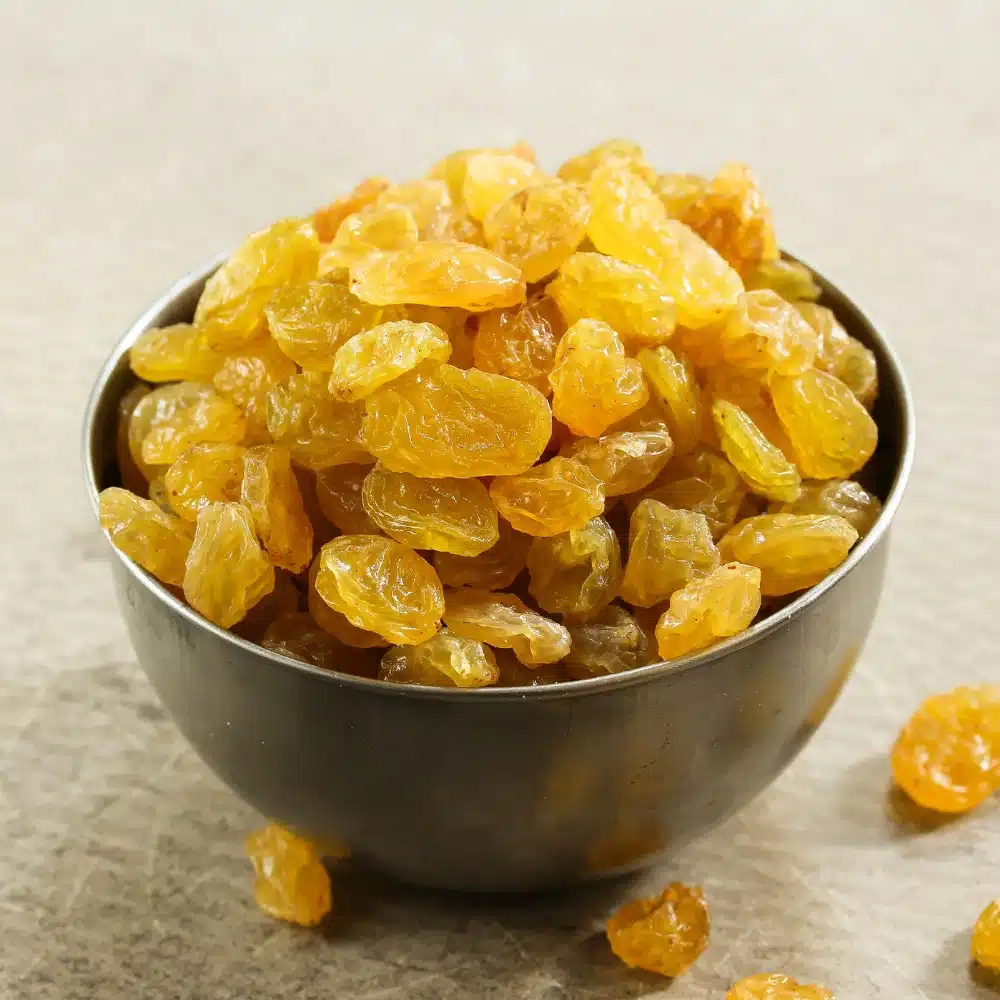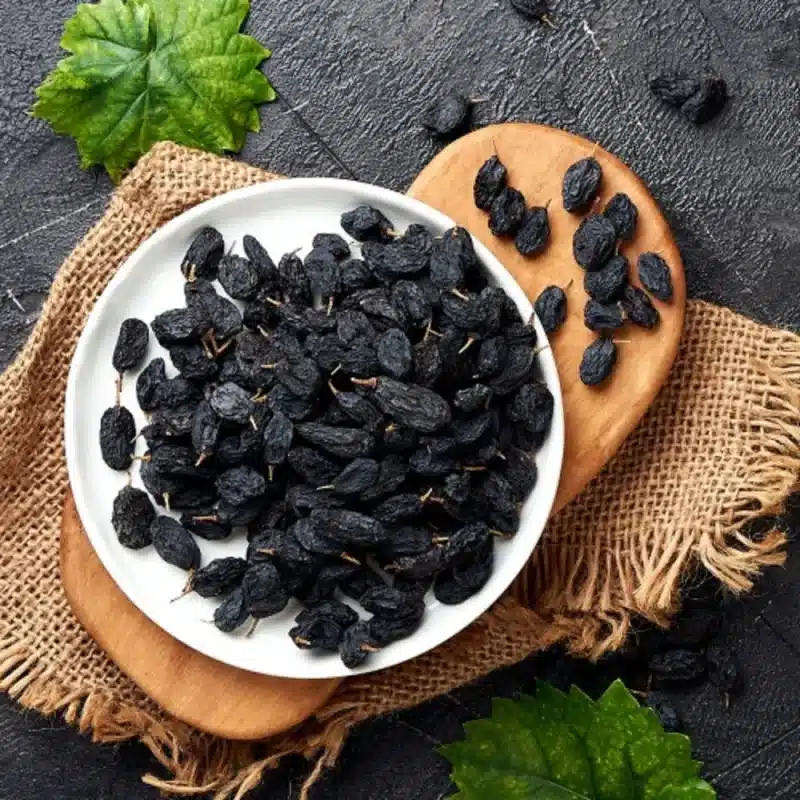Blog
What is the difference between raisins and Kismis?

Origins and Production:
Easier of the two, arrived at when they were commemorated for being sweet, suitable, and long-lasting. Making raisins starts from choosing the best grapes. Grapes such as Thompson seedless or Muscat are typically used since they are sweet and juicy. Then they are picked, while they are fully ripened, and pass through a conversion process where they are naturally dried or machine-dried.
For natural drying also sun-drying the grapes are left out in the open air to get warmed by the sun and the process is very slow during which the sun gently pulls out their water leaving them with concentrated pockets of sweetness. This technique has been used for hundreds of years in places where the sunlight is plentiful. While they give the grapes a depth of flavor and texture, they also give the grapes a sense of sun warmth that comes through with every bite.
Mechanical drying, on the other hand, is characterised by the use of modern technology to accelerate the process. For instance, dehydration or oven-drying might be used in order to achieve the same results in a much shorter time. Some specialists argue that the first method is more accurate and faster but this can’t be compared to the warmth and lightness of the sun. Therefor we can say that raisins may be delicious but tough to eat.
Kismis are a variant of currants that are obtained from Black Corinth grapes. It is a small, seedless type. These tiny grapes come from the Mediterranean and people adore them as they are very sweet and have a rich taste. They have been enjoyed for hundreds of years. By the drying process Black Corinth grapes turn into the well-loved kismis. These types of grapes are mostly cultivated in Greece, Turkey and the neighboring countries.
For instance, in its conventional method, kismis are dried in the sun by methodically placing bunches of grapes on trays or mats and exposure them to the Mediterranean sun. Currants are small but incredibly flavorful. They are solid black in color and their sweet taste is what makes them special against raisins. The old method of preservation of food not only enhances the natural sugars in the grapes but also brings a complexity and depth of taste from where they came from.
Nutritional Profile:
Not only are they tasty, raisins and kismis provide multiple health benefits, which makes them a great dietary addition. They provides quick and easy energy as well as all the needed nutrition. They are loaded with vitamins, minerals, and fiber, and they are delicious either as a savory meal or a snack.
Raisins contain a wider range of vitamins and minerals provided by an array of grape varieties compared with kismis which are smaller and made from a single variety. They are rich in vitamin C, potassium and iron that play key roles such as supporting the body’s immune system, regulating water balance and oxygen transport. In addition, raisins have phytonutrients like resveratrol, which are found in grape skins and are known for their antioxidant properties that can benefit your health.
On the other hand, the kismis grapes although small, contain a lot of vitamins, minerals, and antioxidants. Raisins might appear to be healthier than kismets as they are bigger, but Kismets actually contain many nutrients and lots of energy when compared to raisins. They contain many antioxidants, such as quercetin, which can be good for reducing inflammation and oxidative stress. Vitamin K is a vital vitamin for bone health and blood clotting.
Also, both raisins and kismis rich in dietary fiber, which, helps your digestive system and makes you feel full. The fact that their fast-absorbed natural sugars provide you with energy makes them a good snacks before or after workout. These candies are also delicious and chewy; therefore, you can eat them instead of processed sweets.
Culinary Applications:
Raisins and kismis can be used in all kinds of dishes originating from different countries because they provide a sweet, fruity flavor and a chewy texture. The dried fruits with their natural sweetness and flavor depth can improve any food, and they can be used in dishes like sweets, baked goods, meats, or condiments.
Raisins bring a special sweetness and chewiness to baked goods, such as oatmeal cookes, cinnamon rolls, Moroccan tagines and Indian biryanis, among others. They add a nice flavor and moisture to the bread, muffins and cakes. In savory dishes, their mild sweetness is the counterbalance to the savory tones of meat, grain and vegetable.
Mediterranean and Middle Eastern cuisines can feature raisins in delightful rice pilafs. They blossoms with herbs, nuts and spices, which is lovely to smell and creates a diverse mix of tastes and textures. Moreover, they are main components of traditional treats like rice pudding, baklava, and fruit compotes with honey, nuts, and warm spices revealing their natural sweetness.
Kasmis, with their intense sweetness and small size, are the most valued for their incomparable level of richness and depth of flavor that you cannot find in the other sweets. They are added to cookies, cakes, and other baked foods as they are sweet and chewy, blending perfectly with the buttery dough and creamy sauces.
Kismis, a popular addition to Greek and Turkish desserts like melomakarona and baklava, are cherished. They provide for these treats a rich, sweet taste and floral scents. Additionally, they are used in savory dishes such as pilafs. Cooking them brings out the sugars in them, that caramelise, adding a slight sweetness and the crunchy texture.
And, naturally, raisins and kismis are fantastic in savory foods such as meat dishes, salads, and sauces, where their natural sweetness and depth of flavor is added into the dish. They are usually mixed with the salty taste of onions, garlic or herbs to create new taste and an adventure for you in a kitchen.
Cultural Significance:
Aside from being tasty, kismis and raisins also have cultural value. They symbolize fertility, abundance, and wealth in many cultures and religions worldwide.
Raisins have a long and interesting history in the world. In cultures that are as different as ancient Egypt, Greece, and Rome, they have been associated with life, regeneration, and divine approval. They are essential parts of religious events and celebrations, where they symbolize the sweetness of life and the hope of harvest. In Greek mythology raisins were believed to be a gift from the gods, a sign that they are protecting and supporting humans.
Raisins have also been associated with folklore legends as well as literature. In these environments, they are often endowed with magical or symbolic abilities. For instance, in the European culture, raisins were believed to have supernatural power that could repel bad spirits and welcome good fortune both for those who ate them.
In the same manner kismis are very important for the cultures of countries like Greece, Turkey, and the Middle East where they are grown. They are symbol of sweetness, joy, and community and you can usually find them in the meals at weddings, holidays and religious occasions.
Greeks and Turks use kismis in their Christmas and Easter sweets recipes. They symbolize the sweetness of life and the hope of prosperity in the upcoming year. Besides that, they are given as gifts on the special days by the friends and family to show their love and friendship.
The disparities between kismis and raisins turn out to be as intricate and fine as the fruits themselves. Ranging from their origins and methods of production to their nutritional value and culinary function, these dried fruits are a true melange of tastes, textures and stories that are sure to get anyone interested and excited.
The raisins and kismis are always astonishing and attractive to many people, no matter whether they are taken as a healthy snack, an exciting ingredient or a reminder of family history and custom. They constantly remind us of nature’s glory and the ability of food to restoring the body, cheer the soul, and unite people throughout different periods in the history.
XII. FAQs About Raisins and Kismis
Q1: Can raisins and Kismis be used interchangeably in recipes? A: Yes, in many recipes, raisins and Kismis can be used interchangeably, although the choice often depends on the specific flavor and texture desired.
Q2: Are Kismis healthier than raisins due to their regional significance? A: Both raisins and Kismis offer similar nutritional benefits. The choice between the two is more about culinary traditions and personal preference.
Q3: Do raisins and Kismis have added sugars? A: Generally, good quality raisins and Kismis do not have added sugars. However, it’s essential to check the packaging for any additional ingredients.
Q4: Can I make raisins and Kismis at home? A: Yes, both raisins and Kismis can be made at home by sun-drying grapes. However, the process requires patience and proper drying conditions.
Q5: Are raisins and Kismis suitable for individuals with diabetes? A: Raisins and Kismis have natural sugars and should be consumed in moderation by individuals with diabetes. It’s advisable to consult a healthcare provider or a nutritionist for personalized guidance.
Q6: Can I store raisins and Kismis for a long time? A: Yes, both raisins and Kismis have a relatively long shelf life. To maintain their freshness, store them in an airtight container in a cool, dry place.
Q7: Are there any specific recipes that highlight the unique flavors of Kismis? A: Absolutely! Kismis are often used in traditional Indian desserts like Kheer, Gulab Jamun, and various biryanis, where they enhance the dish’s sweetness and texture.
Q8: Are there any regional varieties of Kismis with distinct flavors? A: Yes, different regions might have their unique varieties of dried black grapes, leading to subtle flavor differences in Kismis. Exploring local markets can introduce you to these regional delights.
Q9: Can raisins and Kismis be part of a weight loss diet? A: In moderation, both raisins and Kismis can be included in a balanced diet for their nutritional value. However, portion control is crucial, as they are calorie-dense.
Q10: Are there any festivals or cultural events where raisins and Kismis hold particular significance? A: Yes, in many cultures, both raisins and Kismis are used in special dishes prepared during festive occasions, symbolizing sweetness, prosperity, and happiness.





“This blog is a fantastic resource for beginners looking to explore the world of dry fruits.”